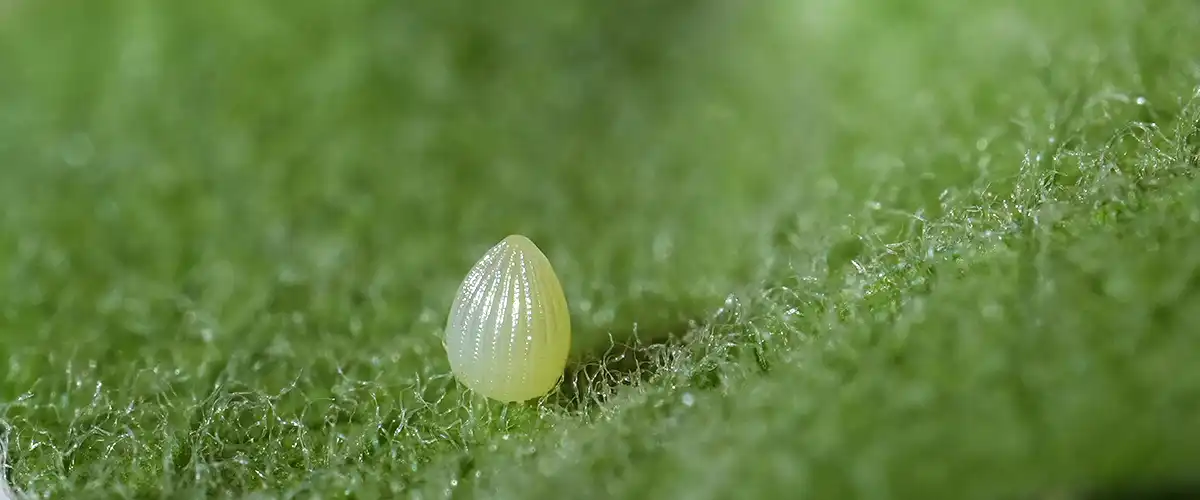This page may contain affiliate links.
Read our disclosure and privacy policy here.
Monarch butterflies are incredible creatures with a fascinating lifecycle. This summer season, you can help save monarch eggs while giving your kids an amazing educational experience. Here’s a step-by-step guide to finding, rescuing, and raising monarch butterflies at home.
Table of Contents
How To Raise Monarch Butterflies From Eggs
Step 1: Finding Monarch Eggs
Where to Look: Monarch butterflies lay their eggs on the underside of milkweed leaves. Look in high-risk areas like the edges of construction sites, parks, and sidewalks where pesticides might be sprayed. The goal is to try to get the eggs before pesticides are sprayed on the plants. If the eggs are laid after pesticides are sprayed, the hope then is to try to save the caterpillars after they hatch from the eggs. More on that further down.
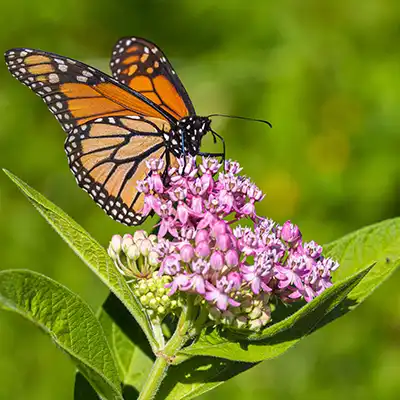
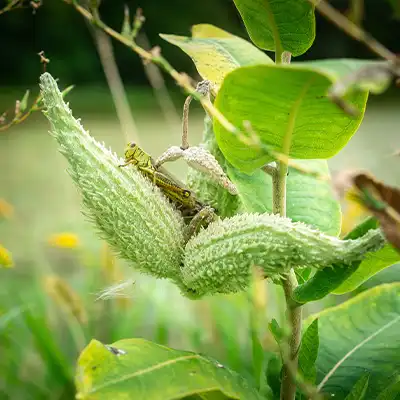
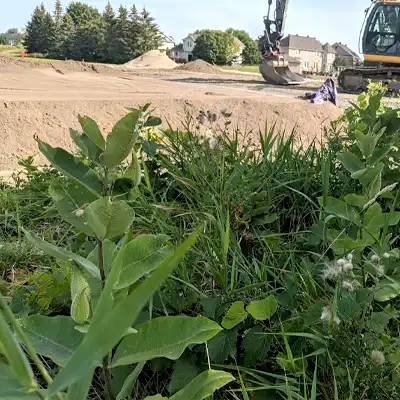
Identifying Monarch Eggs: Monarch eggs are small, white, and oval-shaped. They are usually found on the underside of the leaf. When you do look on the underside of a milkweed leaf, you’ll often find a variety of little white blobs you may mistake as monarch eggs, like mites, spiders, or other insect eggs. Be careful not to confuse them with Monarch eggs. Monarch eggs have a slight sheen and are about the size of a pinhead.
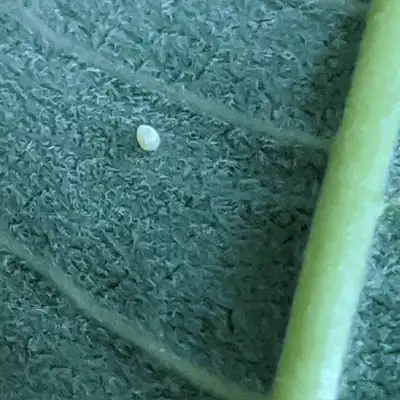
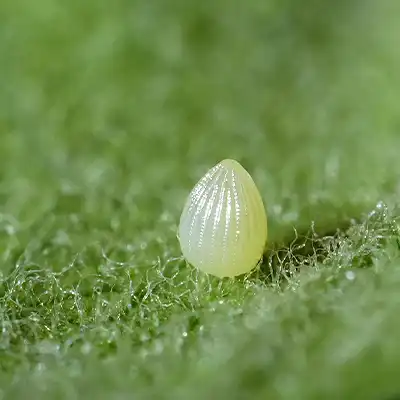
Step 2: Collecting the Leaf
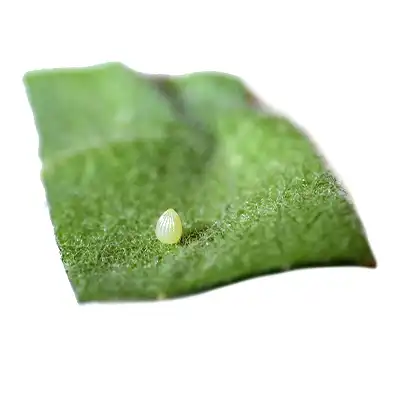
Carefully Collect the Leaf: Once you find a monarch egg, gently take the leaf it’s on. Be cautious of the milkweed sap, which can irritate the skin. Wear gloves or wash your hands afterward.
Preparing the Leaf: Cut a small square around the egg, leaving the egg attached to the piece of leaf. Place this leaf piece in a clear container with a lid. Make sure the container has ventilation holes to prevent humidity buildup. Avoid placing the container in direct sunlight.
Step 3: Watching for Hatching
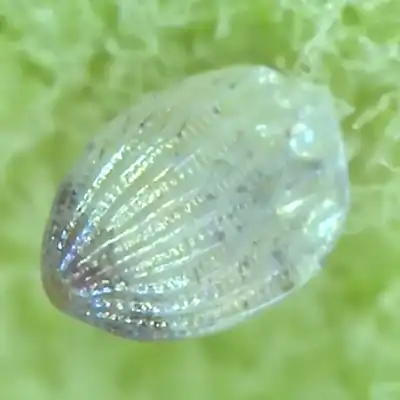
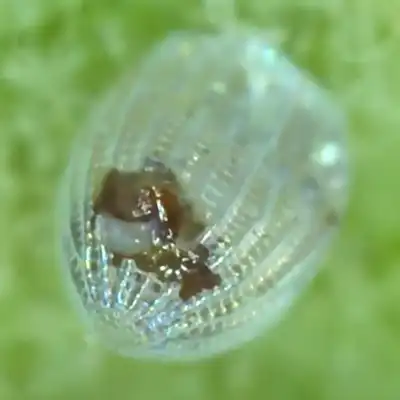
Egg Development: The leaf will eventually dry up, but keep an eye on the egg. Just before it hatches, you’ll see a black dot appear on the egg – this is the caterpillar’s head.
First Meal: Once the caterpillar hatches, it will eat its eggshell. After that, it will look for fresh milkweed leaves. Place the cut square leaf on top of a fresh milkweed leaf from a safe source, and place this entire leaf in a container. The caterpillar will naturally move to the fresh leaf after it is done eating it’s egg casing.
Step 4: Caring for the Caterpillar
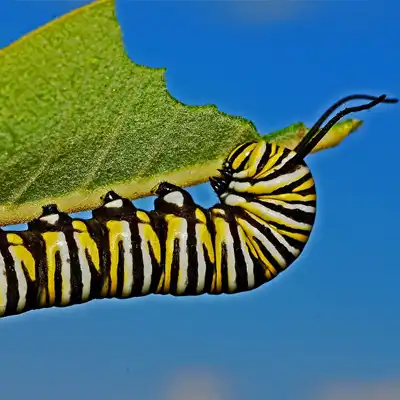
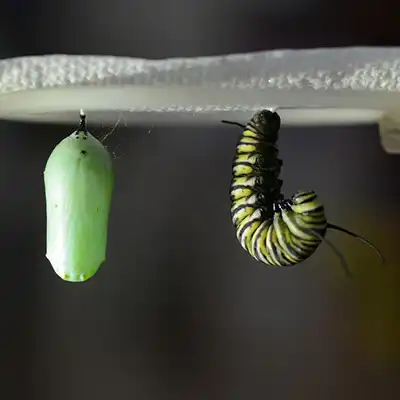
Daily Care: Caterpillars need fresh milkweed leaves daily. As they eat and grow, they will molt (shed their skin) several times. Make sure the container is tall enough for the caterpillar to move freely and eventually hang from the top to form a chrysalis. A clear deli container or a mesh butterfly habitat works well.
Cocoon Time: It takes about 10-14 days for the caterpillar to form a chrysalis. You’ll notice it climbing to the top of the container and spinning a silk pad to hang from. Once secured, the caterpillar will hang in a distinctive J shape, signaling it is almost ready to transform. Soon, it will shed its skin one last time to reveal the chrysalis.
Step 5: Handling the Chrysalis
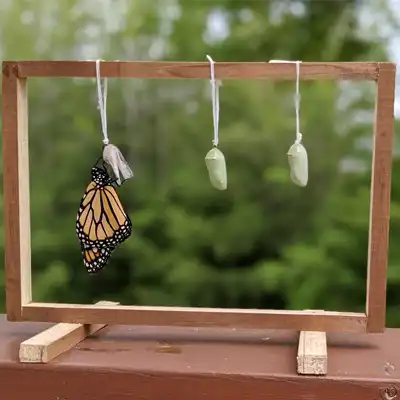
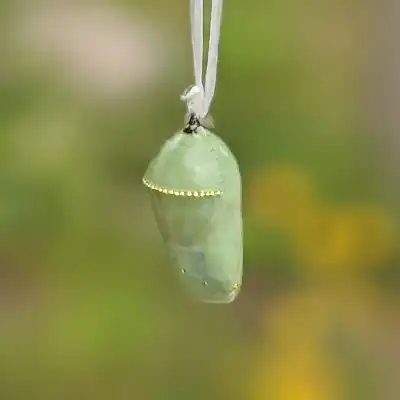
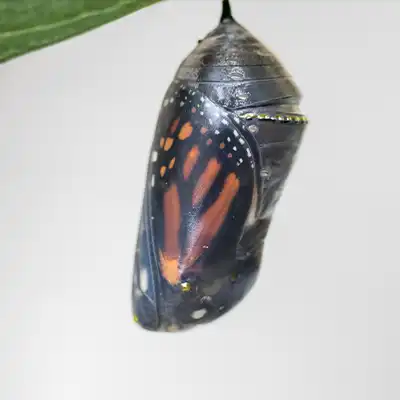
Securing the Chrysalis: After a day or two, the chrysalis will harden. You can carefully remove it from the lid by gently tearing the silk. Be very careful not to break the chrysalis. Use dental floss or string to tie the chrysalis to a frame, keeping it near a window indoors.
Development Time: It takes about 10-14 days for the butterfly to develop inside the chrysalis. During this time, you can observe the changes as the chrysalis gradually becomes clearer.
Step 6: Releasing the Butterfly
Emerging Butterfly: When the chrysalis becomes transparent, you can see the monarch inside. This means it’s almost time for it to emerge. When the butterfly comes out, it will hang onto the chrysalis for a while to dry its wings.
Release: Once the wings are dry and the butterfly starts to move, you can gently take it outside. Watch as it flies away to begin its journey.
FAQ: 10 Questions Kids Ask The Most About Monarch Butterflies
What do monarch butterflies eat?
Adult monarch butterflies drink nectar from flowers like milkweed, asters, and lantanas. This nectar gives them energy to fly and migrate. When they are caterpillars, they only eat milkweed leaves. The leaves provide all the food they need to grow big and strong.Why do monarch butterflies migrate?
Monarch butterflies migrate to find warmer weather during winter because they cannot survive the cold. They travel thousands of miles to places like Mexico and California. In Mexico, they stay in special forests with oyamel fir trees. In California, they gather in eucalyptus, Monterey pine, and cypress trees. This helps them stay warm and safe until it’s time to return north in the spring to lay eggs.How long does it take for a monarch to grow from an egg to a butterfly?
It takes about 4 weeks for a monarch to grow from an egg to a butterfly. First, the egg hatches in 3-5 days. Then, the caterpillar (or larva) stage lasts 10-14 days, during which it eats a lot and molts (sheds its skin) five times. Finally, the caterpillar forms a chrysalis and stays inside for another 10-14 days before emerging as a butterfly.What do monarch eggs look like?
Monarch eggs are tiny, about the size of a pinhead. They are oval-shaped, creamy white, and have a slight shine. The eggs are usually laid one at a time on the underside of milkweed leaves. They have small ridges running from top to bottom, which help to identify them.Why do monarch caterpillars only eat milkweed?
Monarch caterpillars only eat milkweed because it provides all the nutrients they need to grow. Milkweed contains special chemicals called cardenolides, which make the caterpillars taste bad to predators. This helps protect them from being eaten. The toxins from the milkweed stay in the butterfly’s body even after it becomes an adult, making them distasteful to birds and other animals.How can you tell if a monarch is a male or female?
Male monarch butterflies have two black spots on their hind wings, which are scent glands used to attract females. The black veins on their wings are also thinner and less pronounced. Female monarch butterflies do not have these black spots and have thicker black veins, making it easier to tell them apart.What happens inside the chrysalis?
Inside the chrysalis, the caterpillar’s body turns into a gooey liquid through a process called histolysis. Special cells called imaginal discs use this liquid to build the butterfly’s body parts, like wings, legs, and antennae. This transformation, called metamorphosis, takes about 10-14 days. During this time, the butterfly’s new body forms inside the chrysalis.How far can monarch butterflies migrate?
Monarch butterflies can fly up to 3,000 miles during their migrationMigration is the regular movement of animals from one place to another, often to find food or better weather. It’s a seasonal trip that many animals take for survival. Learn More. They travel from places like the United States and Canada to their winter homes in Mexico or California. This journey is amazing because it covers such a long distance, and it often takes multiple generations of butterflies to complete the trip.Why are monarch butterflies important?
Monarch butterflies are important because they help pollinate flowers. When they drink nectar, they transfer pollen from one flower to another, which helps plants produce seeds and grow. Monarchs are also part of the food chain, serving as food for birds and other animals. Scientists study monarchs to understand more about environmental health and the effects of habitat loss and climate change.How can we help protect monarch butterflies?
We can help protect monarch butterflies by:- Planting Milkweed: Milkweed is the only plant that monarch caterpillars eat. Planting milkweed in gardens and yards provides food for caterpillars.
- Growing Nectar Flowers: Flowers that produce nectar, like coneflowers, zinnias, and lantanas, provide food for adult butterflies.
- Avoiding Pesticides: Pesticides can harm butterflies and other beneficial insects. Using natural pest control methods helps keep them safe.
- Joining ConservationThe act of protecting and preserving natural resources and the environment. Conservation efforts are important to protect beavers and their habitats. Efforts: Programs like Monarch Watch help track monarch populations and protect their habitats.
- Spreading Awareness: Teaching others about monarch butterflies and their importance helps more people take action to protect them.
Engaging Discussion Topics about Monarch Butterflies
Introduction: Rescuing and raising monarch butterflies is not only a fun activity but also a great way for kids to learn about nature and conservation. Here are five engaging discussion topics to help parents and kids delve deeper into the project and explore various aspects of the monarch butterfly’s life and environment.
1. The Life Cycle of Monarch Butterflies
Questions to Ask:
- What are the different stages in the life cycle of a monarch butterfly?
- How long does each stage last?
- Why is each stage important?
Discussion Points:
- Explain the stages: egg, caterpillar (larva), chrysalis (pupa), and adult butterfly.
- Discuss how each stage helps the butterfly grow and develop.
- Talk about what the caterpillars eat (milkweed) and why it’s important for their survival.
2. The Importance of Milkweed
Questions to Ask:
- Why do monarch caterpillars only eat milkweed?
- What happens if there isn’t enough milkweed for the caterpillars?
- How can we help make sure there is enough milkweed for monarchs?
Discussion Points:
- Explain that milkweed provides essential nutrients and toxins that protect the caterpillars from predators.
- Discuss the impact of habitat loss and pesticide use on milkweed availability.
- Explore ways to plant milkweed in gardens and parks to support monarch populations.
3. The Amazing Migration Journey
Questions to Ask:
- Where do monarch butterflies migrate to, and why?
- How do they know where to go?
- What challenges do they face during migration?
Discussion Points:
- Talk about the long journey monarchs take to Mexico and California to escape the cold.
- Explain how they use environmental cues like the sun and magnetic fields to navigate.
- Discuss the dangers they face, such as bad weather, lack of food, and habitat destruction.
4. The Impact of Pesticides on Monarchs
Questions to Ask:
- What are pesticides, and why are they used?
- How do pesticides affect monarch butterflies and other insects?
- What can we do to reduce the use of harmful pesticides?
Discussion Points:
- Explain that pesticides are chemicals used to kill pests, but they can also harm beneficial insects like monarchs.
- Discuss the effects of pesticides on monarch eggs, caterpillars, and adults.
- Explore alternative pest control methods and ways to create pesticide-free zones in your garden.
5. Conservation and How We Can Help
Questions to Ask:
- Why are monarch butterflies considered an endangered species?
- What can we do at home to help protect monarchs?
- How can we spread awareness about the importance of conserving monarchs?
Discussion Points:
- Talk about the threats monarchs face, such as habitat loss, climate change, and pesticide use.
- Discuss actions like planting milkweed, creating butterfly habitats, and participating in communityA community is all the living organisms in an ecosystem. This includes animals, plants, fungi, and bacteria. It does not include dirt, rocks, water, and other non living things. science projects administered by local conservation organizations.
- Explore ways to educate friends and family about monarch conservation and encourage them to take action.

There’s a lot to explore right where we are, in our own neighborhoods and backyards! Join us while we get off the couch and explore the everyday wonders of nature, science, space, engineering, art, and anything else we stumble upon during on our adventures.


